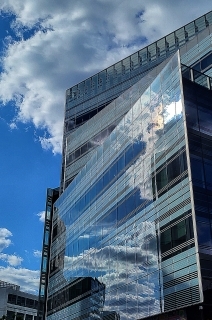Adam Yamey's Blog: YAMEY, page 47
July 2, 2024
From rural Cornwall to the Royal Academy in London
ONE OF MY FAVOURITE National Trust properties in England is Trerice, which is about 2.3 miles south of the Cornish town of Newquay – not one of my favourite places in Cornwall. We visit the house and gardens at Trerice every time we spend time in Cornwall, and always discover soothing there that we had not noticed before.
This tine (June 2024), one of the volunteers working in the house pointed out a painting by John Opie (1761-1807). I had not come across his name before. Our informant told us that he had been born in Cornwall, and thought that he had been involved with the establishment of the Royal Academy. He was born at Trevallas between St Agnes and Perranporth, both of which are not far from Trerice. At an early age, his artistic talents became evident, but his father, a carpenter, wanted John to become a carpenter. A physician, Dr Wolcot, met him at the place where he was an apprentice, and reecognising John’s artistic skills, paid for him to be released from his apprenticeship. Wolcot encouraged Opie, and by the start of the 1790s, he was a successful portraitist in Cornwall.
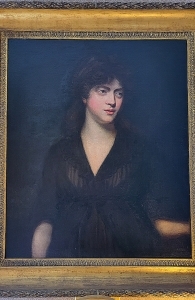
In 1781, Wolcot took Opie to London, where his works were admired by great artists of the time including Sir Joshua Reynolds, who compared John’s work to that of Caravaggio and Velasquez. A year later, Opie began working independently of Wolcot, who had been supporting him up until then. An acquaintance of Dr Wolcot introduced Opie to the court of King George III. This led to Opie being commissioned to paint portraits of people of high rank in English society and royalty. In 1886, he was elected a full member of the Royal Academy, and in 1805 he was appointed a professor in that esteemed institution.
There are three paintings by Opie hanging on the walls of Trerice house. One is a portrait, and another a self-portrait. The third, which depicts three people playing cards, is a copy of the same picture that can be seen at Petworth house. The version at Trerice is believed to have been painted by Opie and others in his studio. Each of the three people in it have smiles. It is thought that in this painting, Opie was experimenting with the depiction of smiling. Although attractive, this picture is not as attractive as his other two paintings in Trerice.
It is always pleasant to re-visit places, and always exciting to discover something one had missed on earlier trips to that same location. As well as the lovely interiors at Trerice, the gardens surrounding it are always a joy to behold.
July 1, 2024
The forgotten wig in the west of Devon
TAVISTOCK IS A SMALL town just west of the Dartmoor National Park. Between the year 974 and 1539, when it was closed by King Henry VIII, there was a vast abbey in the centre of the town. A few remnants of the abbey buildings can be seen today, but most of the complex has disappeared. The Guildhall, built in 1848, stands upon land where the abbey once stood. Today, this edifice houses a well organised museum, which illustrates various aspects of the town’s history. Visitors can see the courtroom and the old prison cells beneath it.
Within the courtroom, there is an intriguing exhibit: a judge’s wig in a glass case. This wig was discovered recently when the Guildhall was being restored a few years ago. It is the kind of wig worn by judges in the 1840s. The wig contained its owner’s name: Mr JW de Longueville Giffard.
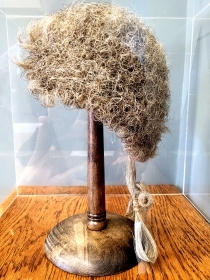
The researchers connected with the museum discovered that Mr Giffard attended court one day in October 1888. He had been presiding at Okehampton the week before, and had fallen ill. Unwilling to cancel his session at Tavistock, the conscientious judge attended the court on that October day, feeling extremely unwell. He died the following day. Because he was in such a bad state on the day before his death, he must have forgotten to take his wig back home with him.
130 years later, the unfortunate judge’s wig was found in a cupboard in what had once been the judges’ robing room.
June 30, 2024
An Albanian who fought the Portuguese in India during the 16th century
MY NEW BOOK IS ABOUT THE LIFE AND ADVENTURES OF AN ALBANIAN HERO WHO FOUGHT THE PORTUGUESE IN INDIA DURING THE 16TH CENTURY
“AN ALBANIAN IN INDIA” is available
as a paperback and a Kindle eBook from Amazon:
ABOUT THE BOOK
The Albanian, known as ‘Khwaja Safar’, was born in southern Italy. Just as the Albanian national hero Skanderbeg fought the invaders of Albania, Khwaja Safar valiantly opposed the invaders of his adopted country – Gujarat.
After serving as a soldier in Italy, he went to sea as a trader, and was successful. While sailing in the Red Sea, he was captured by an Egyptian admiral, and taken to Cairo. He was presented to the Sultan. Khwaja rose rapidly to become the treasurer and trusted advisor ruler of Egypt’s ruler. From Egypt, he travelled to Yemen, and then to Gujarat in western India, where he became a formidable opponent of the Portuguese, who were aggressively attempting to monopolise trade in the Indian Ocean. With his knowledge and experience of the tactics of European armies, he became Portugal’s most formidable opponent in 16th century western India.
My book (also available as a Kindle eBook), “AN ALBANIAN IN INDIA”, is illustrated with pictures and maps. It describes Khwaja Safar’s extraordinarily exciting life and my visits to places where he made his mark in India.
CLICK BELOW TO REACH THE AMAZON PAGE FOR MY NEW BOOK:
June 29, 2024
Picturesque piles of rock and standing in the landscape of Devon
WHENEVER WE DRIVE to Cornwall, we make sure that we cross Dartmoor. Even if it means taking a detour along the narrow, challenging lanes of Devon, we always visit Combestone Tor. This geological formation, perched on the side of a hill commanding a panoramic view of well over 180 degrees, consists of several piles of enormous, weathered slabs of granite. Each pile has a few of these gigantic slabs piled one above the next. I have described how these impressive piles were formed in something I wrote a few years ago (https://adam-yamey-writes.com/2020/10/04/sculpted-by-nature/).

I cannot say why we find visiting Combestone Tor so satisfying. Is it the fine views over the moor and the countryside abutting it? Or is it the sculptural qualities of the rock formations? Could it be the peacefulness of the place? Even if there are other visitors at the Tor, one does not feel disturbed by them. Or is it the joy of seeing horses, sheep and cattle grazing near the stones? It is probably a combination of all of these, and other factors which affect one’s emotions, but are difficult to define. We have seen the Tor in appalling wind and rain and bright sunshine, and always feel glad that we have made the effort to reach the place.
June 28, 2024
Japanese by design in London’s Kensington
SEVERAL MONTHS AGO, I watched a wonderful film set in Japan and directed by Wim Wenders: “Perfect Days”. Set in Tokyo, the main character is a man who cleans the city’s public toilets. Each of the public conveniences he cleans is of a different design. And each of them, like so many things designed in Japan, is a beautiful work of art. Making things and places look special and visually pleasing seems to be an important feature of the Japanese philosophy of life, and has been since time immemorial. Yet, unlike many other countries, Japan has not yet established a dedicated national design museum.
Until the 8th of September 2024, the Japan House in High Street Kensington is hosting an exhibition called “Design Discoveries”. The website of the Japan House (www.japanhouselondon.uk/whats-on/desi...) explained:
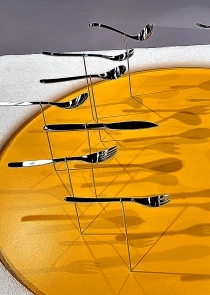
“This exhibition brings together seven major designers, from filmmakers to architects, to consider what they would put into a permanent collection of design treasures. Their personal responses capture Japan’s regional diversity and 10,000 years of history.”
The beautifully laid out exhibition is not merely educational but also a feast for the eyes. Examples of Japanese design (and technology) dating from about 4500 years ago to the present century are beautifully displayed and intelligently explained.
Should the Japanese eventually get around to creating a museum of design, I am certain that visiting it would be a very exciting experience. Meanwhile, if you can get to Japan House – a beautifully designed place – you should not miss visiting the exhibition in its basement.
June 26, 2024
Hunger games ?
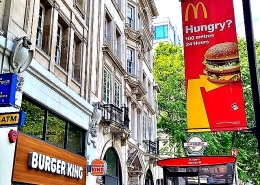
HUNGER GAMES ???
They are competing for your custom. This juxtaposition was spotted (by me) in London’s Kingsway.
Sculptures on display in the garden of a square in central London
ON OUR WAY FROM Bury Street (near Piccadilly) to Trafalgar Square, we walked through the garden in the centre of St James Square. In addition to its permanent resident, a bronze equestrian statue of King William III (sculpted in 1807), the garden contained several sculptures by Helaine Blumenfeld, who was born in New York City in 1942. Her artistic education was in the USA and France. In 1970, she moved to Grantchester in Cambridgeshire where she lives and works. She was awarded an OBE in 2011.
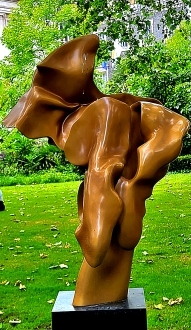
The works on display in the square until the 26th of July 2024 have been presented by the Hignell Gallery. Although the sculptures, which are almost but not completely abstract, are made of folded sheets of metal, they look like large pieces of cloth being blown by the wind. To enjoy them fully, it is a good idea to walk around each of them. As you encircle each sculpture, you keep seeing something different. Some of the pieces reminded me a little of certain sculptures created by Tony Cragg (born 1949). Like Cragg’s sculptures, Blumenfeld’s creations are well-suited for open air display.
It was a pleasure to see these sculptures in St James Square on a hot, sunny day, when the garden was populated by office workers on the lawn, enjoying the sun and their lunches.
June 25, 2024
He lived and painted in and around London’s Hampstead district
TWO HALF-BROTHERS from India were both artists, and spent time creating artworks in and around Hampstead. Lancelot Ribeiro (1933 – 2010) was one of them, and the other was his older and more famous brother Francis Newton Souza (1924-2002). Today (23rd of June 2024), we dashed up to Hampstead’s Burgh House to see an exhibition of works by Souza created when he lived in Hampstead and Belsize Park. This small, but superb exhibition closes today.
Born in Portuguese Goa, Souza studied art at the prestigious JJ School of Art in Bombay. A participant in the Quit India Movement, he was expelled from that school in 1945 when he pulled down a Union Jack flag at a school celebration. Souza migrated to the UK in 1949. By 1955, he was already making a success in London’s contemporary art world.
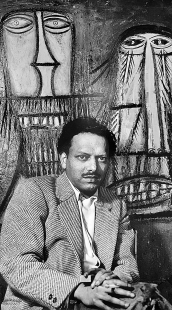
In London, Souza first lived in Paddington, then North Kensington, and by the mid-1950s, he had moved to Hampstead. By 1961, he had made enough money to buy a large house – number 9 Belsize Park. He remained there until he moved to the USA in 1968.
The exhibition handout (produced by London’s Grosvenor Gallery) described Souza as an Expressionist artist who:
“… conveyed the fear and anguish of the generation.”
One of the great fears was that of nuclear weapons. Souza became an anti-nuclear activist, taking part, for example, in the Aldermaston Marches. Three of the paintings at the exhibition, “The Mad Prophet of New York”, “The Apocalypse”, and “Oedipus Rex”, reflected Souza’s reaction to nuclear weaponry, and were painted during his time in the Hampstead area.
At least two of the paintings we viewed reflected Souza’s life in northwest London. One of them depicts a church in Chalk Farm (near Belsize Park), and the other, a parody of Picasso’s 1907 “Demoiselles d’Avignon”, has the title “Young Ladies of Belsize Park”.
The paintings were hung in the well-lit Peggy Jay Gallery in Burgh House, and were accompanied by informative panels. It is a shame that this excellent exhibition was only open for a few days (19th to 23rd of June 2024). I am glad that we made the effort to see it.
June 24, 2024
Celestial reflections in Hammersmith
June 23, 2024
Three buildings of historic interest in London’s Endell Street
IN THE 1980s, there was a shop that sold a variety of products imported from Communist Albania, which was then ruled by the Stalinist dictator Enver Hoxha and, after 1985, by his successor Ramiz Alia. I visited it once or twice. Although it had a few items of interest, it was quite expensive. The shop, which had closed by 1990, was in Betterton Street, which leads from Drury Lane to Endell Street, which is not far from the Seven Dials.
Yesterday (20th of June 2024), we walked along a part of Endell Street and then into Betterton Street, on our way to the Garden Cinema (in Parker Street). We watched a completely weird, arthouse film called “Daisies”, which was made in Communist Czechoslovakia in 1966. Despite being awarded a Czech film prize in 1966, it was banned by the censors in 1967.
Returning to Endell Street, we spotted three buildings of interest. The first of these is on the southeast corner of Endell Street and Shorts Gardens. It bears a commemorative plaque that reads:
“Zepherina Veitch (1836 -1894) Dame Rosalind Paget (1855 – 1948) Pioneering midwives trained at the British Lying-in Hospital, founded 1739 and sited here, 1849 – 1913.”
The tall Victorian building, to which this plaque is attached, is red brick with white stone facings. Between 1849 and 1913, this place housed a hospital for married women in the last month of pregnancy. A website concerned with former hospitals (https://ezitis.myzen.co.uk/britishlyingin.html) related:
“The staff consisted of two physicians and two surgeons who practiced midwifery, a Matron skilled in the same, a chaplain, an apothecary, nurses and ‘other inferior servants’. Women were admitted in the last month of their pregnancy – they were only permitted to stay for three weeks – and needed a letter of recommendation from a subscriber (patients were not charged by the Hospital) and an affidavit of their marriage and their husband’s settlement.”
Adjoining the former lying-in hospital, there is an edifice made with layers of bricks that vary in colour and white stone trimmings. It has Victorian gothic features, and its Endell Street facade bears an inscription, which reads:
“Lavers and Barraud Stained Glass Works”
This firm was founded in 1858 by Nathaniel Wood Lavers (1828–1911) and Francis Philip Barraud (1824–1900). When Barraud (of Huguenot descent) became dissatisfied with the firm’s designs, he was recommended to hire Nathaniel Westlake (1833-1921) as a designer. Westlake’s knowledge of mediaeval art and skills in the pre-Raphaelite style of art brought fame and fortune to the firm in the 1860s. In 1858. He became one of the firm’s partners, and in 1880, he became the firm’s sole owner.
A building on the corner of Betterton Street and Endell Street, across the road from the former stained glass works bears a plaque that informs the viewer that in this house, number 20 Endell Street, Westlake resided in the 1880s. His firm continued in business until his death.
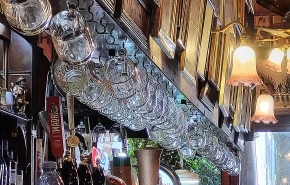
So, today, neither the lying-in hospital nor the stained-glass works are still operating, and the Albanian shop has long gone. However, one place that would have been in business when those two places were functioning, is still in business: The Cross Keys Pub. Established in 1848, this pub has a baroque Victorian façade. The interior of this long narrow hostelry is most people’s idea of a real old-fashioned pub. A long bar with brass fittings runs along one side of the saloon, The walls are covered with numerous paintings and prints and several glass cases containing stuffed (taxidermy) fish. All manner of things, including a brass instrument and an archaic diver’s helmet, are suspended from the ceiling. Yet, despite this great amount of assorted ‘clutter’, the pub has a cosy atmosphere. When we dropped in for some mid-afternoon refreshment, there were a few other customers – mostly elderly local people. Although in the heart of the city, the pub has a rustic feeling about it. I suspect that workers and other staff from the stained-glass factory used to pop into the Cross Keys for liquid refreshment. But I wonder if many of those associated with the lying-in hospital -staff or patients – were patrons.
After dallying in Endell Street, we walked the short distance to the Garden Cinema in Parker Street to see the Czech film. If you have not been to this cinema, you are missing a treat – it is a truly independent, art-house cinema (see www.thegardencinema.co.uk).

